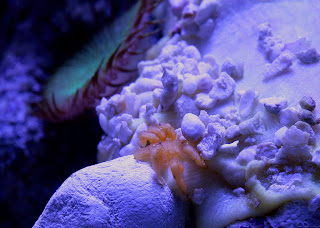Who says you can't grow SPS corals under LED lighting? In the background is a flourescent green "acorn stag" Acropora sp. and in the foreground is an A. valida coral. I originally had the green stag mounted alone on a rock, but a portion of my wildly growing A. valida grew onto the same rock and declared war at the base where they met. Several months ago, I moved the rock to a higher location in the tank and broke the connecting coral. Today, I dislodged the rock and turned it around in order to show more of the A. valida. And, because it is positioned closer to the LED lights than the mother colony, the polyps are more colorful.
This variability in color quality as a consequence of lighting intensity is a similar property in reef tanks using metal halide, T5 or PC lighting. So, one must figure out the optimal placement for each coral before committing it to its permanent location.
This variability in color quality as a consequence of lighting intensity is a similar property in reef tanks using metal halide, T5 or PC lighting. So, one must figure out the optimal placement for each coral before committing it to its permanent location.

This amphipod was found in between the glass and the Subcurrent filter in the Nano tank. I wanted to get a clear picture of it because of the fore claws. I can see how it can easily be confused for a baby Mantis shrimp. Although, I should do some research to see what a baby Mantis really looks like!
At the base of a Devil's hand leather coral, I found this sea spider. They have a bad reputation for feasting on soft corals and prized collections of zoanthids. I really wouldn't mind if it mowed down the uncontrolled yellow zoanthids in my tank. I shouldn't take the chance and find that a mate is ready to do some serious multiplying. So, I'll have to extract it soon.







No comments:
Post a Comment